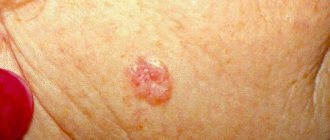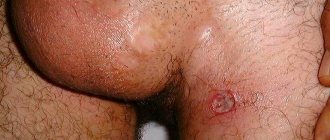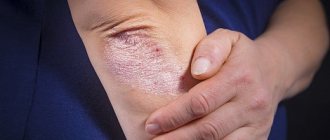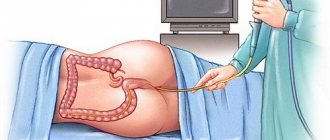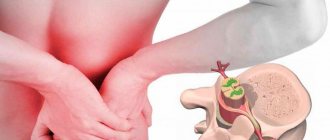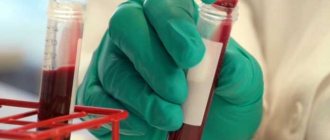Bowen's disease is a separate dangerous type of carcinoma that can spread along the plane of the skin. As a rule, the patient does not feel pain. The disease changes its appearance to an unpleasant one. The affected area constantly peels off, forming plaques.
This pathology is rare. The main sign that the skin is altered by the disease is the presence of pale pink formations. There is only one thing, or there is a cluster. The disease is localized in the surface layer - the epidermis. Neoplasms do not form metastases, which means they do not pose a threat to internal organs. There is a danger that, in the absence of therapeutic measures, the cells will degenerate into squamous cell or invasive cancer. In this case, metastases and full-fledged skin cancer will appear with an increase in the affected area.
It is noted that Bowen's disease affects older people:
- In men, the development of pathology is observed in the period 40-70 years;
- In women, skin carcinoma is diagnosed starting at age 50.
In childhood, the disease manifests itself much less frequently.
The International Classification of Diseases classifies Bowen's disease as skin carcinoma, ICD-10 code D00-D09. Localization of the lesion is observed in different places:
- The appearance of affected areas of skin on the head in 45% of cases.
- Mucosa of the genital organs, on the palms, other mucous membranes on the face in 10% of cases.
- Other places in the human body are affected less frequently.
Bowen's disease sign on the hand
Etiology
In 99% of cases, the disease appears at 60-70 years of age, however, it is not always possible to determine exactly why it occurs.
The most common causes are the following:
- exposure to sunlight on skin, especially light skin, since it is less protected from ultraviolet radiation;
- temporary changes in the epithelium, skin aging;
- repeated trauma to the skin;
- exposure to chemical components (arsenic, alkali, pesticides);
- papilloma virus;
- due to a depressed immune system - immunosuppression;
- chronic dermatoses;
- other diseases affecting the skin.
Due to the influence of unfavorable factors, metabolism is disrupted and their death is accelerated. Those cells that come to replace them will already be genetically changed, their structure and function will be disrupted.
The first to be affected is the spinous layer of the skin as a result of deformation and improper cell division.
In the interval, when the tumor has not yet come out, it is located behind the membrane in the middle layers of the skin and is defined as carcinoma (within the epithelium). This is a malignant formation, but given that there are no blood vessels in the epithelium, the pathology does not metastasize and does not affect other organs in 97% of cases.
Classification
The disease has no gender restrictions, but Bowen's disease is more common in men, localized on skin areas (on the head), on mucous membranes (in the mouth, on the tongue, on the tip of the penis), and in women it appears on the genital organs very rarely, in isolated cases. cases.
Symptoms of Bowen's disease
Four forms of such a tumor are classified:
- anular - has a round appearance with a raised edging in the shape of a ring, due to this it is also called annular;
- verrucous - characterized by a convex shape with small growths, its second name is warty;
- pigmented - these are plaques with a dark color, as they contain a large amount of melanin;
- nail bed disease – leads to nail destruction.
Most often, this pathology manifests itself in old age (after 60 years), and is very rare in young people.
Symptoms
The neoplasm has the appearance of an ulcer with uneven edges, but clear boundaries, with a color ranging from bright red to red-brown. The ulcers may be smooth or have a granular surface. After a short period of time, the plaque begins to peel off, and its size ranges from two to five centimeters.
There are not only single plaques, but sometimes several, the nodules are located close to each other, and as they grow they can unite or merge, entering each other.
Plaques can be in the form of spots, or they can be convex. They are found not only on the skin, but also on the mucous membranes of the body. If the plaque turns into erosion or ulcer, then the disease is progressing and requires intervention.
Bowen's disease in the mouth is the same as on the surface of the skin, but the gums and teeth can be affected, causing problems in the future. Considering that the plaque in the mouth is constantly injured and turns into an ulcer, stomatitis may appear.
Very rarely, erosions cause itching: more often, simply peeling of the damaged surface occurs. This is a distinctive feature of this disease that there is no pain, burning or severe itching, it does not spread throughout the entire skin, but has isolated localized foci.
Symptoms of intraepidermal cancer
The disease affects the mucous membranes or skin, resulting in the formation of a small pale red spot with blurred boundaries. After a certain period of time (everyone is different), the neoplasm turns into a plaque, colored yellow-red.
Its surface is covered with small scales that easily fall off, leaving behind a slightly moist wound without signs of injury (no bleeding, pain, etc.).
As this plaque develops, the surface of the formation becomes more and more heterogeneous. It clearly shows warty growths, atrophic changes and hyperkeratosis. The lesion grows in different directions, and the boundaries begin to gradually rise above the skin. At the very beginning, the diameter ranges from 2-3 mm, after which it can reach 5-6 cm.
By the time of degeneration from a precancerous state into a malignant tumor, numerous small ulcers appear on the surface of the plaque. In this case, there is only one lesion, but depending on the severity of the disease, new ones may appear, which will subsequently merge with the main one into a single whole.
If Bowen's cancer appears on the mucous membrane or eyelids, it will look like papilloma (single and slightly inward plaques). Formation near the nail plates is fraught with destruction of the stratum corneum to the very end. These are the characteristic symptoms that make it possible to clearly identify the disease.
In order to start treatment in a timely manner, you need to know what symptoms this disease has. Thanks to this, it is possible to stop the development of the disease in the early stages and prevent the appearance of cancer, as well as reduce the number of possible complications.
If you suddenly find that irritation or spots of unknown etiology have appeared on your skin, you should visit a dermatologist who will prescribe a more thorough examination.
Bowen's disease manifests itself in several stages:
- First, a spot appears with blurred edges. Over time, it not only grows, but also turns into a flat plaque. The affected surface constantly itches, and specific scales form here. When they are removed, the surface of the plaque is slightly moist, but does not bleed at all.
- Over time, the plaque grows and absorbs more and more healthy skin. Gradually the edges begin to rise and growth intensifies.
- If the disease is not stopped in the early stages of development, Bowen's disease develops into a new form of cancer. In this case, there is a sharp appearance of ulcers of various sizes on the entire surface of the plaque.
- A neoplasm on the mucous membranes initially leads to the appearance of red, smooth lumps, which later turn into bleeding ulcers.
Most often, the disease manifests itself on the inner surface of the foreskin. Moreover, the disease has a chance to change into a malignant tumor, for example, squamous cell carcinoma.
Men who are not circumcised as children are more likely to develop Bowen's disease between the ages of forty and seventy. But, it is important to note that its localization is not only the foreskin, but also the mucous membranes (soft palate, tongue, uvula).
Bowen's disease also occurs on the body. For example, sometimes cancer can be localized in the areas behind the ears or on the fingers.
Women in whom it is localized on the genitals also have a minimal chance of contracting this disease.
At the initial stage, the oncovirus manifests itself in the form of an uneven spot, which gradually forms into a plaque. It has the appearance of erosion, some may confuse it with eczema, as it is red in color with a copper tint, covered with crusts and dead epithelium, and also tends to enlarge when irritated.
The characteristic shade of a skin tumor is obtained as a result of both hyper- and hypopigmentation.
The diagnosis can be confirmed by histological examination by an oncologist.
Bowen's disease is often confused with a skin disease - psoriasis, since it also produces characteristic plaques that have a similar variegated color with uneven scales. But an important feature that distinguishes the first type of disease from the other is the presence of a ridge, a characteristic sign of subcutaneous cancer, which cannot be said about psoriasis.
Sometimes, the lesions of the disease are similar to eczema, but if rubbing in medicinal steroid ointments does not lead to the desired effect, then the oncologist may assume that the patient has Bowen's disease.
Diagnostics
During the examination, the specialist must take into account that Bowen's disease has a number of symptoms that may be similar to other diseases, which complicates the accuracy of the diagnosis and allows for the possibility of errors.
Such diseases include:
- psoriasis – a nodular rash with many plaques, accompanied by severe itching;
- eczema - numerous rashes appear, often with blisters containing liquid inside;
- superficial carcinoma - depending on the type, causes metastases;
- actinic keratosis - numerous rashes with pain and itching;
- seborrheic keratosis - single and multiple benign formations with burning and itching;
- lichen planus – round in shape, manifested by an itchy rash;
- herpes zoster – the infection is accompanied by very severe pain;
The pathology must be differentiated from all kinds of diseases of the nails and mucous membranes.
Externally, the diseases are very similar in type and color, but in order to exclude some varieties, it is necessary to take a biopsy of the affected tissue. Using a biopsy, you can confirm the diagnosis and identify the degree of development, as well as determine treatment options.
If the pathology turns into cancer, then there will be a immersion deep into the dermis and cell deformation, while the basement membrane is destroyed.
Causes
The causes of this disease can be different.
Most often, Bowen's disease develops as a result of exposure of the human body to any carcinogenic factors, for example, ionizing radiation or ultraviolet radiation. Expert opinion Sakania Luiza Ruslanovna
Dermatovenerologist, cosmetologist, trichologist
Ask a Question
Frequent contact with certain chemicals (tar, arsenic, tar) can also have a fairly strong carcinogenic effect. Additional risk factors for the development of Bowen's disease are a keratinized cyst, traumatic damage to the skin (with scarring), and the presence of human papillomavirus (HPV) in the body.
Bowen's disease can also occur against the background of one of the following diseases:
- lichen planus;
- dystrophic epidermolysis bullosa;
- discoid lupus erythematosus;
- Porokeratosis of Mibelli;
- Lewandowski-Lutz epidermodysplasia.
The causes of Bowen's disease may include adverse effects on the skin:
- injury;
- excessive sun exposure;
- contact with various chemical agents;
- infection with human papillomavirus;
- exposure to ionizing radiation.
Long-term chronic dermatoses, such as lupus erythematosus or lichen planus, can also cause pathological changes in skin cells over time.
Treatment
Each case of Bowen's disease requires treatment, which is selected individually. The location of the affected area, the patient’s age, the size and number of lesions, and the state of immunity are taken into account. Sometimes therapy is complex.
The main methods of therapy are:
- chemotherapy - used for large lesions and is carried out in several courses, sometimes used in combination with other methods;
- cryotherapy – liquid nitrogen is applied to defective tissues (used in the initial stages);
- electrical destruction – destruction of the tumor by electric current;
- laser therapy – used if the tumor is large;
- X-ray therapy – if the tumor is on the mucous membrane or tongue;
- Surgical intervention prevents the tumor from deepening, a very effective method.
In rare cases, when the patient has the opportunity to prevent sunlight from reaching the infected area and provided that the pathology does not grow, the doctor chooses a wait-and-see approach, however, if the tumor begins to grow, the patient is sent for surgery.
Treatment of disease using traditional medicine methods
Since Bowen's disease is a precancerous condition, you should never refuse the treatment selected by your doctor. Traditional medicine methods are recommended to be used as additional therapy and only after consultation with the doctor observing the patient.
Celandine infusion is widely used to treat Bowen's disease.
An infusion of celandine can help in the fight against Bowen's disease. An infusion for the day is prepared from a liter of boiling water and four teaspoons of dry raw materials. The strained infusion is divided into four parts and drunk throughout the day. The first dose should be taken on an empty stomach, immediately after waking up, and the last dose should be taken before bed. When treating with celandine infusion, it is necessary to completely eliminate sweets.
A decoction made from dried herb (30 grams of dry herb per glass of boiling water) can also help. A strong infusion is taken in a spoon five times a day. In addition, you can prepare an ointment based on this infusion by mixing it with honey and oil (ratio 1:2:2). The ointment is used for compresses on affected areas of the skin.
An external medicine can also be prepared from hemlock herb extract. To do this, 5 grams of extract are mixed with 350 ml of lime water. The liquid is used to irrigate lesions on the skin and compresses.
A decoction prepared from Japanese Arizema also helps to cope with the disease. It is necessary to use the roots of a plant collected in the spring before the first leaves appear.
Possible complications
Complications when diagnosed with Bowen's disease will be as follows;
- swollen lymph nodes;
- complications after anesthesia;
- poor healing of the cleaned area;
- formation of a node or lump, which is a relapse;
- adverse reactions to medications used in therapy.
Timely treatment measures will prevent the patient’s condition from worsening and prevent the occurrence of a cancerous tumor.
Surgical methods
Many patients undergo surgical removal of the tumor. It is very effective because malignant cells do not penetrate deep into the skin and do not metastasize. The skin formation is excised with a scalpel. After removing the pathological focus, sutures are applied, and a scar is subsequently formed. The operation is performed under local anesthesia.
For better cosmetic results, micrographic Mos surgery is used. It is especially indicated for large lesions on the head, neck, and fingers. During the intervention, the surgeon, under microscopic control, removes layer by layer, while simultaneously analyzing the resulting tissue under a microscope. As soon as the formation is removed to a healthy layer, the intervention is stopped. Mos surgery is the most effective treatment for Bowen's disease.
View photos
[collapse]
Prevention
For preventive purposes, patients who have had Bowen's disease are recommended to:
- avoid direct exposure to sunlight on the skin and head, use special clothing for this (light but closed);
- apply special sunscreen creams;
- promptly treat various injuries, treat them with special disinfectants;
- treat skin diseases in a timely manner and under the supervision of a specialist.
It is necessary to undergo medical examination once a year to identify pathology at an early stage.
What is Bowen's disease?
One form of malignant skin tumors, Bowen's disease, was described in 1912 by the American dermatologist John Bowen. It is a squamous cell carcinoma in situ (“in place”) with a tendency to grow peripherally. Large pathological lesions can reach several centimeters in size.
They are practically painless; they may have peeling or plaques. Bowen's disease is a variant of intraepidermal carcinoma, that is, it originates in the thickness of the superficial skin layer - the epidermis. It is caused by the malignant degeneration of cells that form the dense proteins of the skin - keratinocytes.
The disease is considered a precancerous condition. Other scientists classify it as an early stage of skin cancer. Subsequently, the disease can transform into invasive squamous cell skin cancer with an aggressive course and rapid metastasis.
